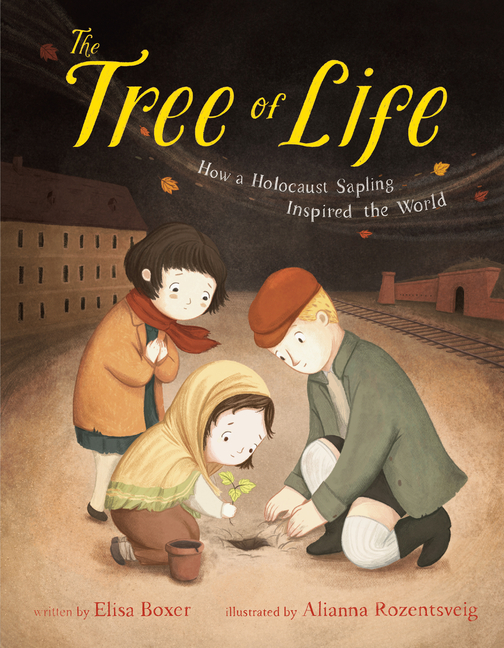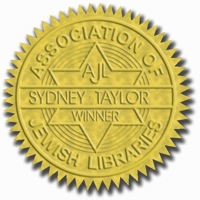
Book Resume
for The Tree of Life: How a Holocaust Sapling Inspired the World by Elisa Boxer and Alianna Rozentsveig
Professional book information and credentials for The Tree of Life.
4 Professional Reviews
1 Book Award
Selected for 1 State/Province List
See full Book Resume
on TeachingBooks
- School Library Journal:
- K - Grade 4
- Booklist:
- Grades 1 - 3
- Kirkus:
- Ages 5 - 8
- Publisher's Weekly:
- Ages 5 - 9
- TeachingBooks:*
- Grades PK-6
- Lexile Level:
- 690L
- Genre:
- Biography
- Nonfiction
- Year Published:
- 2024
3 Subject Headings
The following 3 subject headings were determined by the U.S. Library of Congress and the Book Industry Study Group (BISAC) to reveal themes from the content of this book (The Tree of Life).
4 Full Professional Reviews
The following unabridged reviews are made available under license from their respective rights holders and publishers. Reviews may be used for educational purposes consistent with the fair use doctrine in your jurisdiction, and may not be reproduced or repurposed without permission from the rights holders.
Note: This section may include reviews for related titles (e.g., same author, series, or related edition).
From School Library Journal
January 26, 2024
K-Gr 4-Boxer and Rozentsveig provide a story of hope in this book, focusing on the life and legacy of a maple tree planted in secret by Irma Lauscher, a Jewish teacher, and students in Terezin (located in modern-day Czech Republic). Miraculously, both the teacher and the tree survive the Holocaust and WWII. Subsequently, seeds from the tree are planted around the world; those trees are still thriving today, despite the original "dropping its last leaf" in 2007. The difficult subject matter feels more approachable both through the narrative's language and accompanying soft illustrations. A sparingly used, intense red indicates the Nazis' presence and amplifies with a jolt the otherwise earth-toned artwork. After the narrative, an author's note provides additional information about the descendants of the original tree, the teacher, and the location itself. Selected sources are also included. Front end papers feature fall-colored foliage on a black background, while in the back, bright spring colors evoke hope and a new day. VERDICT An approachable and valuable resource. Recommended for most collections.-Taylor Worley
Copyright 2024 School Library Journal, LLC Used with permission.
From Booklist
January 1, 2024
Grades 1-3 Commemorating a living Holocaust memorial, Boxer tells how a seedling maple smuggled into the Terezin camp in a sympathizer's shoe was planted in celebration of Tu BiShvat ("The New Year of the Trees"), nurtured for years by imprisoned children, and survived the war. The children's teacher and others went on to distribute the tree's seeds and cuttings to many places. Though the original tree died in 2007, its progeny will continue to grow and be symbols of survival that, as the author puts it, "honor the past and nourish the future--for generations to come." In Rozentsveig's solemn illustrations, bright-eyed children first gather around a tiny stick in the dirt to marvel and share a few drops of their carefully rationed water before being taken to Auschwitz, and then in final urban scenes they witness workers planting a young tree and later sit in its shade as their teacher reads a story. That the tree-based religious holiday has taken on environmental overtones in recent times adds a further layer of interest to this ongoing act of remembrance.
COPYRIGHT(2024) Booklist, ALL RIGHTS RESERVED.
From Kirkus
November 15, 2023
A tree survives the Holocaust, though most of the children who cared for it don't. It's winter in Terezin, the Czechoslovakian propaganda camp with which the Nazis tricked the credulous Red Cross into believing their treatment of Jews was humane. Here, children are allowed to attend school, and one teacher, Irma Lauscher, has the children plant a smuggled-in maple sapling. Miraculously, the children keep the tree alive in the camp, even as they themselves weaken or die. Art and text combine for an honest yet optimistic and age-appropriate portrayal of a difficult topic. When they first see the tree, the children are still round-faced if ragged, their pale, large-eyed faces capable of joy. As the war continues and the tree grows, the children's faces grow wearier, their bodies huddled against cold and despair. Many of the children vanish entirely; although only the author's note clarifies that these children have been murdered in Auschwitz, a foreboding spread of a deportation train ("taken away on trains to a place that was even worse") nonetheless makes clear that their fates are dire. Despite the mass murder, the tree survives--as does Irma. In 2021, a cutting from the tree was planted in New York City. Now the somber hues, punctuated by reds, give way to a hopeful green surrounding the racially diverse children of New York--round-faced and joyful. A gentle, accessible take on resilience. (sources) (Picture book. 5-8)
COPYRIGHT(2023) Kirkus Reviews, ALL RIGHTS RESERVED.
From Publisher's Weekly
October 9, 2023
Irma Lauscher (1904—1985) carried out two enduring acts of resistance in the Terezin ghetto during WWII. She secretly taught the children imprisoned with her to read, write, and celebrate the Jewish holidays, and with help, obtained a maple sapling in observance of Tu BiShvat. She and her students planted it in a hidden corner, sharing precious drops of water with the growing tree, which became known throughout Terezin as Etz Chaim, the Tree of Life. "Fewer and fewer children were left to care for the tree"â€"one image shows a frightened youth holding a leaf during a deportation to "a place that was even worse." But the tree and Lauscher survive and serve as witnesses: the tree thrives for more than six decades, and Lauscher, who "saw to it that seeds from the tree were planted all over the world," memorializes all of those who were denied a future. Boxer (A Seat at the Table) and illustrator Rozentsveig strike a reportorial tone in measured prose and softly textured digital art of largely pale-skinned historical figures, conveying both the necessity and limits of hope in the darkest of times. An author's note concludes. Ages 5—9. (Jan.) â—
1 Book Awards & Distinctions
The Tree of Life was recognized by committees of professional librarians and educators for the following book awards and distinctions.
1 Selection for State & Provincial Recommended Reading Lists
The Tree of Life was selected by educational and library professionals to be included on the following state/provincial reading lists.
United States Lists (1)
Preview Digital Book
Explore The Tree of Life on Marketplace. Access requires OverDrive Marketplace login.
This Book Resume for The Tree of Life is compiled from TeachingBooks, a library of professional resources about children's and young adult books. This page may be shared for educational purposes and must include copyright information. Reviews are made available under license from their respective rights holders and publishers.
*Grade levels are determined by certified librarians utilizing editorial reviews and additional materials. Relevant age ranges vary depending on the learner, the setting, and the intended purpose of a book.
Retrieved from TeachingBooks on February 04, 2025. © 2001-2025 TeachingBooks.net, LLC. All rights reserved by rights holders.


 Sydney Taylor Book Award, 2001-2025, Honor, 2025
Sydney Taylor Book Award, 2001-2025, Honor, 2025
